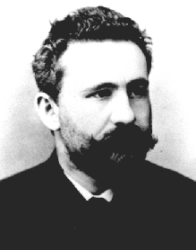
Kraepelinian dichotomy
Encyclopedia

Endogenous
Endogenous substances are those that originate from within an organism, tissue, or cell. Endogenous retroviruses are caused by ancient infections of germ cells in humans, mammals and other vertebrates...
psychoses
Psychosis
Psychosis means abnormal condition of the mind, and is a generic psychiatric term for a mental state often described as involving a "loss of contact with reality"...
into the disease concepts of dementia praecox
Dementia praecox
Dementia praecox refers to a chronic, deteriorating psychotic disorder characterized by rapid cognitive disintegration, usually beginning in the late teens or early adulthood. It is a term first used in 1891 in this Latin form by Arnold Pick , a professor of psychiatry at the German branch of...
, which was reformulated as schizophrenia
Schizophrenia
Schizophrenia is a mental disorder characterized by a disintegration of thought processes and of emotional responsiveness. It most commonly manifests itself as auditory hallucinations, paranoid or bizarre delusions, or disorganized speech and thinking, and it is accompanied by significant social...
by Eugen Bleuler
Eugen Bleuler
Paul Eugen Bleuler was a Swiss psychiatrist most notable for his contributions to the understanding of mental illness and for coining the term "schizophrenia."-Biography:...
in 1911, and manic-depressive psychosis, which has now been reconceived as bipolar disorder
Bipolar disorder
Bipolar disorder or bipolar affective disorder, historically known as manic–depressive disorder, is a psychiatric diagnosis that describes a category of mood disorders defined by the presence of one or more episodes of abnormally elevated energy levels, cognition, and mood with or without one or...
. This division was formally introduced in the sixth edition of Emil Kraepelin
Emil Kraepelin
Emil Kraepelin was a German psychiatrist. H.J. Eysenck's Encyclopedia of Psychology identifies him as the founder of modern scientific psychiatry, as well as of psychopharmacology and psychiatric genetics. Kraepelin believed the chief origin of psychiatric disease to be biological and genetic...
's psychiatric textbook Psychiatrie. Ein Lehrbuch für Studirende und Aertze, published in 1899. It has been highly influential on modern psychiatric classification systems, the DSM-IV-TR
Diagnostic and Statistical Manual of Mental Disorders
The Diagnostic and Statistical Manual of Mental Disorders is published by the American Psychiatric Association and provides a common language and standard criteria for the classification of mental disorders...
and ICD-10
ICD-10 Chapter V: Mental and behavioural disorders
- Organic, including symptomatic, mental disorders :* Dementia in Alzheimer's disease* Vascular dementia** Multi-infarct dementia* Dementia in other diseases classified elsewhere** Dementia in Pick's disease...
, and is reflected in the taxonomic
Classification of mental disorders
The classification of mental disorders, also known as psychiatric nosology or taxonomy, is a key aspect of psychiatry and other mental health professions and an important issue for consumers and providers of mental health services...
separation of schizophrenia from affective psychosis
Mood disorder
Mood disorder is the term designating a group of diagnoses in the Diagnostic and Statistical Manual of Mental Disorders classification system where a disturbance in the person's mood is hypothesized to be the main underlying feature...
.
History
The Kraepelinian system and the modern classification of psychoses are ultimately derived from the insights of the Karl KahlbaumKarl Ludwig Kahlbaum
Karl Ludwig Kahlbaum was a German psychiatrist. In 1855 he received his medical doctorate at Berlin, and subsequently worked as a physician at the mental asylum in Wehlau. For a period of time he was also a lecturer at the University of Königsberg , and from 1867 was director of the mental...
. In 1863 the Prussian psychiatrist published his Habilitation
Habilitation
Habilitation is the highest academic qualification a scholar can achieve by his or her own pursuit in several European and Asian countries. Earned after obtaining a research doctorate, such as a PhD, habilitation requires the candidate to write a professorial thesis based on independent...
which was entitled, Die Gruppirung der psychischen Krankheiten (The Classification of Psychiatric Diseases). In this text he reviewed the then heterogeneous state of medical taxonomies of mental illness and enumerated the existence of some thirty such nosologies from the early seventeenth-century until the mid-nineteenth-century. The major contribution of his published dissertation, which is still the foundation of modern psychiatric nosology, was to first formulate the clinical method for the classification of psychosis by symptom, course and outcome.
Kahlbaum also differentiated between two major groups of mental illnesses which he termed vecordia and vesania.
Emil Kraepelin first introduced his proposed dichotomy between the endogenous psychoses of manic-depressive illness and dementia praecox during a public lecture in Heidelberg, Germany on 27 November 1898.

